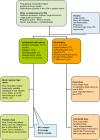Current and emerging treatment options for Graves' hyperthyroidism
- PMID: 20169034
- PMCID: PMC2817786
- DOI: 10.2147/tcrm.s5229
Current and emerging treatment options for Graves' hyperthyroidism
Abstract
Radioiodine, antithyroid drugs and surgery have been well established therapies for Graves' hyperthyroidism for several decades. However there remain large variations in practice among physicians in the preferred modality and the method of administration. Patient choice and perceptions also play a big role in the choice of treatment. Radioiodine may be given using fixed high doses or by calculated doses following uptake studies. The risks of radioiodine including eye disease and the role of prophylactic steroid therapy are discussed. The commonly used antithyroid drugs include carbimazole, methimazole and propylthiouracil; however a number of other agents have been tried in special situations or in combination with these drugs. The antithyroid drugs may be given in high (using additional levothyroxine in a block-replace regimen) or low doses (in a titration regimen). This review examines the current evidence and relative benefits for these options as well as looking at emerging therapies including immunomodulatory treatments such as rituximab which have come into early clinical trials. The use of antithyroid therapies in special situations is also discussed as well as clinical practice issues which may influence the choices.
Keywords: Graves’ hyperthyroidism; antithyroid drugs; methimazole; propylthiouracil; radioiodine.
Figures
Similar articles
-
Outcome of pediatric Graves' disease after treatment with antithyroid medication and radioiodine.Clin Invest Med. 1999 Aug;22(4):132-9. Clin Invest Med. 1999. PMID: 10497711
-
Non-thionamide antithyroid drug options in Graves' hyperthyroidism.Expert Rev Endocrinol Metab. 2023 Jan;18(1):67-79. doi: 10.1080/17446651.2023.2167709. Epub 2023 Feb 5. Expert Rev Endocrinol Metab. 2023. PMID: 36740774 Review.
-
Diagnosis and treatment of Graves disease.Ann Pharmacother. 2003 Jul-Aug;37(7-8):1100-9. doi: 10.1345/aph.1C299. Ann Pharmacother. 2003. PMID: 12841824 Review.
-
[Radioiodine versus surgery in the treatment of Graves' hyperthyroidism].Lijec Vjesn. 2010 Nov-Dec;132(11-12):355-60. Lijec Vjesn. 2010. PMID: 21294325 Croatian.
-
Current trends in antithyroid drug treatment of Graves' disease.Expert Opin Pharmacother. 2016 Oct;17(15):2005-17. doi: 10.1080/14656566.2016.1232388. Epub 2016 Sep 14. Expert Opin Pharmacother. 2016. PMID: 27615550 Review.
Cited by
-
An Effective Straightforward Protocol for the Treatment of Graves' Hyperthyroidism for Primary Care Providers.Curr Trends Intern Med. 2023;7(3):206. doi: 10.29011/2638-003x.100106. Epub 2023 Nov 13. Curr Trends Intern Med. 2023. PMID: 40041425 Free PMC article.
-
Cost-Effectiveness Analysis of Antithyroid Drug (Propylthiouracil) Compared to Radioactive Iodine for the Treatment of Graves' Disease in Ethiopia.Clinicoecon Outcomes Res. 2022 Apr 11;14:221-229. doi: 10.2147/CEOR.S350984. eCollection 2022. Clinicoecon Outcomes Res. 2022. PMID: 35431562 Free PMC article.
-
Pharmacodynamic Response to Anti-thyroid Drugs in Graves' Hyperthyroidism.Front Endocrinol (Lausanne). 2020 May 12;11:286. doi: 10.3389/fendo.2020.00286. eCollection 2020. Front Endocrinol (Lausanne). 2020. PMID: 32477269 Free PMC article.
-
Urticaria as a manifestation of hyperthyroidism.Clin Case Rep. 2021 May 5;9(5):e03620. doi: 10.1002/ccr3.3620. eCollection 2021 May. Clin Case Rep. 2021. PMID: 34084471 Free PMC article.
-
A Rare Case of Thyrotoxic Periodic Paralysis in a Patient With Concomitant Methimazole-Induced Agranulocytosis.AACE Clin Case Rep. 2024 Nov 6;11(1):66-69. doi: 10.1016/j.aace.2024.11.002. eCollection 2025 Jan-Feb. AACE Clin Case Rep. 2024. PMID: 39896956 Free PMC article.
References
-
- Brent GA. Graves’ Disease. N Engl J Med. 2008;358:2594–2605. - PubMed
-
- Wiersinga WM, Bartalena L. Epidemiology and prevention of Graves’ ophthalmopathy. Thyroid. 2002;12:855–860. - PubMed
-
- Vaidya B, Williams GR, Abraham P, Pearce SHS. Radioiodine treatment for benign thyroid disorders: results of a nationwide survey of UK endocrinologists. Clin Endocrinol (Oxf) 2008;68:814–820. - PubMed
-
- Nayak B, Hodak SP. Hyperthyroidism. Endocrinol Metab Clin N Am. 2007;36:617–656. - PubMed
-
- Cooper D. Antithyroid drugs. N Engl J Med. 2005;352:905–917. - PubMed
LinkOut - more resources
Full Text Sources


